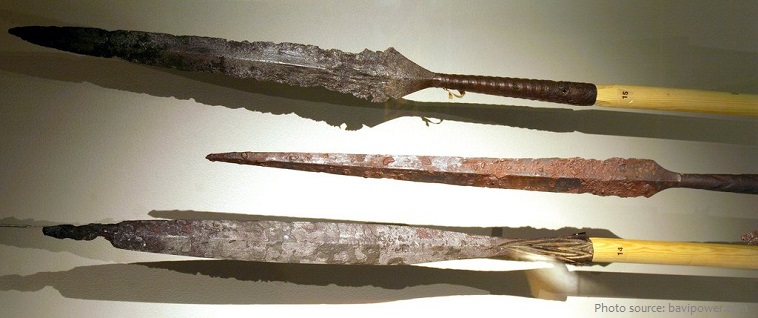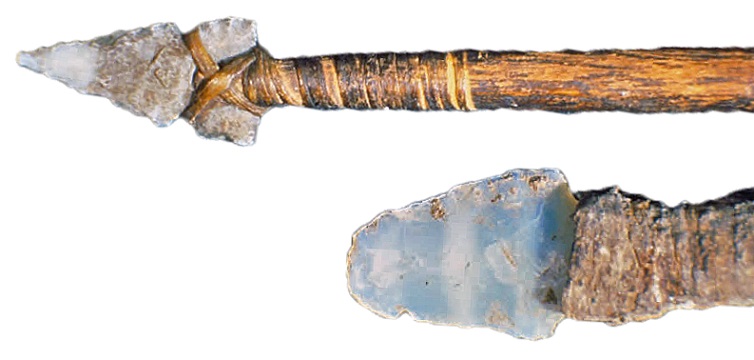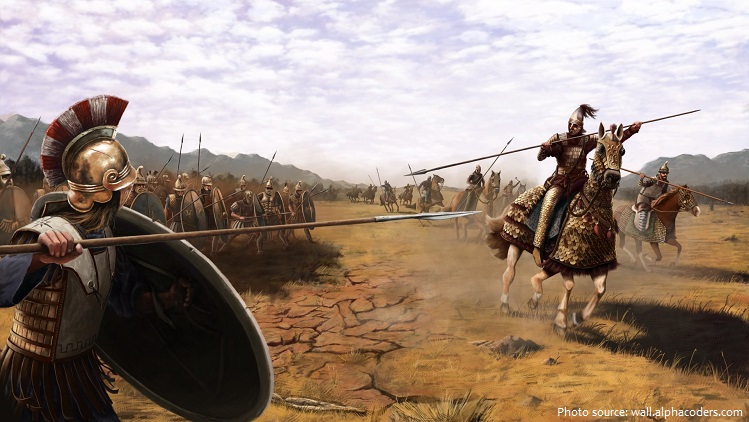
A spear is a weapon consisting of a pole with a sharp, usually metal, point at one end, that is either thrown or held in the hand.
The most common design for hunting or combat spears since ancient times has incorporated a metal spearhead shaped like a triangle, lozenge, or leaf. The heads of fishing spears usually feature barbs or serrated edges.
One of the earliest weapons devised by man, the spear was originally simply a sharpened stick. Primitive peoples used spears primarily as thrown weapons.

Archaeological evidence found in present-day Germany documents that wooden spears have been used for hunting since at least 400,000 years ago.
From circa 200,000 BC onwards, Middle Paleolithic humans began to make complex stone blades with flaked edges which were used as spear heads. These stone heads could be fixed to the spear shaft by gum or resin or by bindings made of animal sinew, leather strips or vegetable matter. During this period, a clear difference remained between spears designed to be thrown and those designed to be used in hand-to-hand combat. By the Magdalenian period (c. 15,000–9500 BC), spear-throwers similar to the later atlatl were in use.
The spear is the main weapon of the warriors of Homer’s Iliad. The use of both a single thrusting spear and two throwing spears are mentioned. It has been suggested that two styles of combat are being described – an early style, with thrusting spears, dating to the Mycenaean period in which the Iliad is set, and anachronistically, a later style, with throwing spears, from Homer’s own Archaic period.
Bronze Age spearheads came in a variety of shapes and lengths, some nearly as small as an arrowhead and others more than a foot long. The oldest bronze spearheads were attached to the shaft with an elongated, tail-like “tang,” but few wooden shafts survive. As metalworkers improved their casting techniques, they produced longer, sharper spearheads with conical sockets into which the wooden shaft was inserted and bolted into place.
Bronze spearheads closely followed the development of alloys hard enough to keep a cutting edge and represented, with the piercing ax, the earliest significant military application of bronze. Spearheads were also among the earliest militarily significant applications of iron, no doubt because existing patterns could be directly extrapolated from bronze to iron. Though the hafting is quite different, bronze Sumerian spearheads of the 3rd millennium BC differ only marginally in shape from the leaf-shaped spearheads of classical Greece.

The spear-carrying phalanx, or massed formation of closely ranked men, was used by Sumerian armies as early as 3,000 BC. Two thousand years later the Greeks refined the concept, using pikes 2 to 3 m (6 to 9 feet) long. Around 350 BC, Philip II of Macedon introduced the sarissa, a pike 4 to 6.5 m (13 to 21 feet) long that gave the Macedonian infantry an extra reach before the pike blades of the opposing Greeks could reach them. These close formations of men marched or ran toward their opponents bristling with spear points, which they then thrust into the enemy’s line. Alexander the Great used sarissa-equipped infantry to conquer his huge empire.
Javelins or throwing spears were shorter and lighter than spears designed for shock combat and had smaller heads. The distinction between javelin and spear was slow to develop, but by classical times the heavy spear was clearly distinguished from the javelin, and specialized javelin troops were commonly used for skirmishing.

In the Chinese martial arts, the Chinese spear is popularly known as the “king of weapons”. The spear is listed in the group of the four major weapons (along with the gun (staff), dao (a single-edged blade similar to a sabre), and the jian (sword)).
The various types of the assegai (a light spear made of wood and pointed with iron or fire-hardened tip) were used throughout Africa and it was the most common weapon used before the introduction of firearms. The Zulu, Xhosa and other Nguni tribes of South Africa were renowned for their use of the assegai.
Typically, most spears made by Native Americans were created with materials surrounded by their communities. Usually, the shaft of the spear was made with a wooden stick while the head of the spear was fashioned from arrowheads, pieces of metal such as copper, or a bone that had been sharpened. Spears were a preferred weapon by many since it was inexpensive to create, could more easily be taught to others, and could be made quickly and in large quantities.

Native Americans used the buffalo pound method to kill buffalo, which required a hunter to dress as a buffalo and lure one into a ravine where other hunters were hiding. Once the buffalo appeared, the other hunters would kill him with spears. A variation of this technique, called the buffalo jump, was when a runner would lead the animals towards a cliff. As the buffalo got close to the cliff, other members of the tribe would jump out from behind rocks or trees and scare the buffalo over the cliff. Other hunters would be waiting at the bottom of the cliff to spear the animal to death.
Spear manufacture and use is not confined to humans. It is also practiced by the western chimpanzee. Chimpanzees near Kédougou, Senegal have been observed to create spears by breaking straight limbs off trees, stripping them of their bark and side branches, and sharpening one end with their teeth. They then used the weapons to hunt galagos sleeping in hollows.
